一、cookie
- 解释: 用来保持服务器和浏览器交互的状态的, 由服务器设置,存储在浏览器
- 作用: 用来做广告推送
- cookie的设置和获取
- 设置cookie: response.set_cookie(key,value,max_age)
- max_age: 表示cookie在浏览器的存储时间,单位是秒
- 获取cookie: request.cookies.get("key")
- 设置cookie: response.set_cookie(key,value,max_age)
from flask import Flask, make_response, request
app = Flask(__name__)
#设置cookie
@app.route('/set_cookie')
def set_cookie():
#调用make_response方法获取响应体对象
response = make_response("set cookie")
#设置cookie
response.set_cookie("computer","lenovo")
response.set_cookie("age","13",10)
return response
#获取cookie
@app.route('/get_cookie')
def get_cookie():
#获取cookie
name = request.cookies.get("computer")
age = request.cookies.get("age")
#返回
return "name is %s, age is %s"%(name,age)
if __name__ == '__main__':
app.run(debug=True)
二、session
- 解释: 服务器和用户来做状态保持的,里面存储的是敏感信息(比如身份证,登陆信息),由服务器设置,并存储在服务器
- 作用: 用来做用户的登陆状态保持
- session的设置和获取
- 设置session: sessioin[key] = value
- 获取session: value = session.get(key)
- 注意点:
- 1.session的存储依赖于cookie
- 2.存储在cookie中的sessionID需要加密,需要秘钥(SECRET_KEY)
from flask import Flask, session
app = Flask(__name__)
#设置SECRET_KEY,此时就是随意的字符串
app.config["SECRET_KEY"] = "sdofinsidofnsfdas"
#设置session
@app.route('/set_session/<path:name>')
def set_session(name):
session["name"] = name
return "set session!"
#获取session
@app.route('/get_session')
def get_session():
value = session.get("name")
return "set session, name is %s"%value
if __name__ == '__main__':
app.run(debug=True)
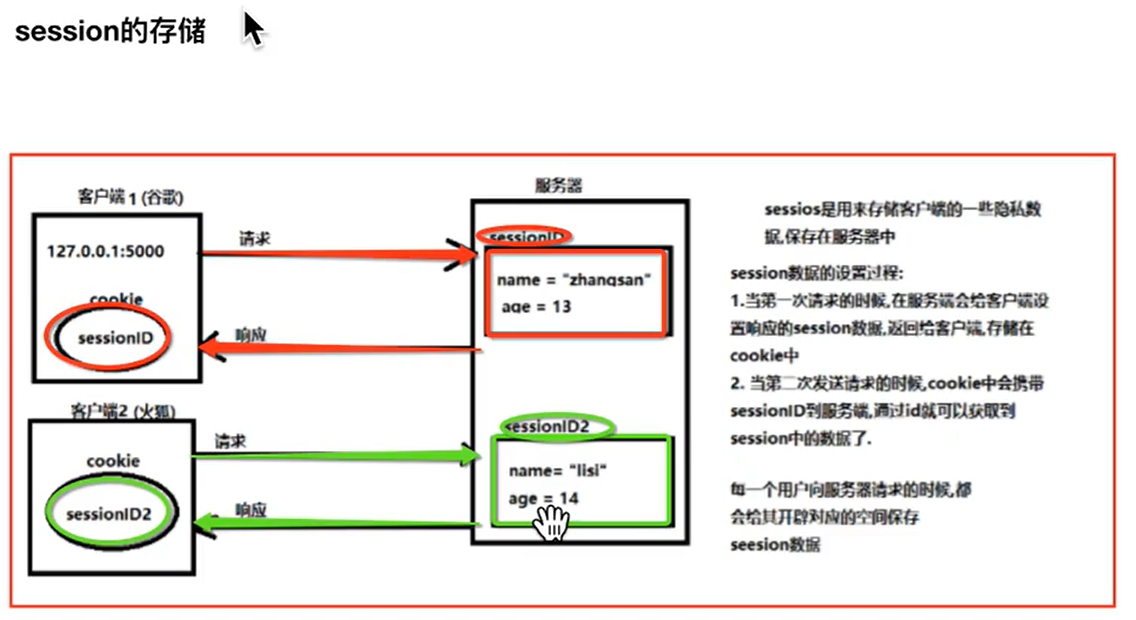
三、上下文
- 解释: 就是一个容器
- 请求上下文
- request: 封装的是请求相关的数据
- session: 封装的是和用户相关的敏感信息
- 应用上下文(在项目中具体应用)
- current_app: 是app的一个代理对象,可以通过他获取app身上设置的各种属性,主要用在模块化开发中
- g: 一个局部的全局变量,主要用在装饰器中
from flask import Flask, current_app
app = Flask(__name__)
@app.route('/')
def hello_world():
print(app.config.get("DEBUG"))
print(current_app.config.get("DEBUG"))
return "helloworld"
if __name__ == '__main__':
app.run(debug=True)
四、Flask_script
- 解释: 属于flaks的扩展
- 作用: 用来动态运行程序,配合flask_migrate做数据库迁移
- 使用格式:
- 1.安装
- pip install flask_script
- 2.导入Manager类
- 3.创建对象manager,管理app
- 4.使用manager启动程序
- 启动命令: python xxx.py runserver -h(host是IP地址) -p(端口号) -d(调试模式)
- 1.安装
from flask import Flask
from flask_script import Manager
app = Flask(__name__)
app.config["DEBUG"] = True
#3.创建对象manager,管理app
manager = Manager(app)
@app.route('/')
def hello_world():
return "helloworld"
if __name__ == '__main__':
manager.run()


五、render_template
- 解释: 属于jinja2的模板函数
- 好处:
- 1.以后的视图函数,只负责业务逻辑的处理,比如: 数据库的增删改查
- 2.以后数据的展示,全部都有jinja2的模板负责
- 使用格式:
- response = render_template('模板文件',key=value)
模板文件写在自动生成的templates目录下
如果是自己建的目录需要这样
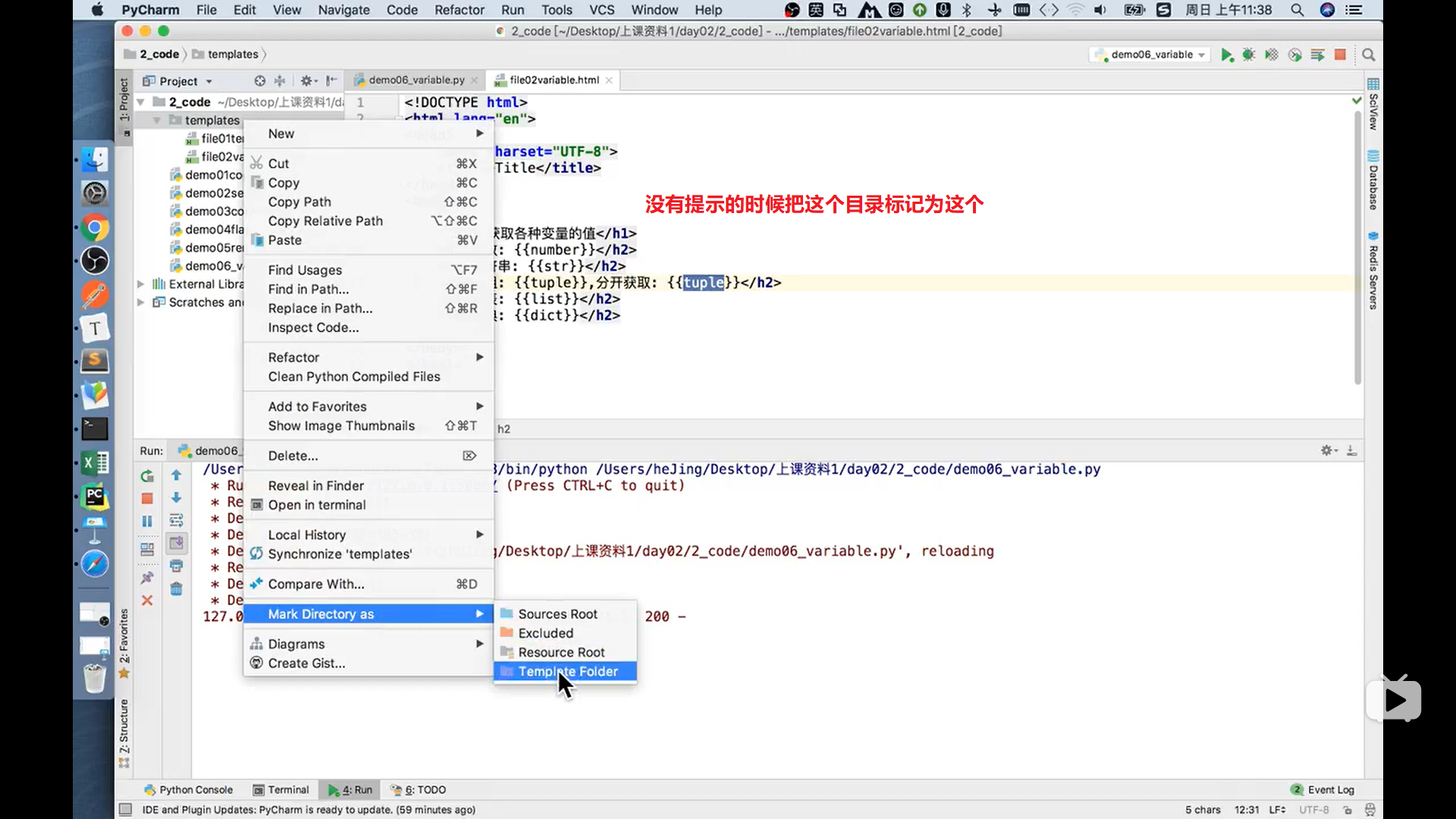
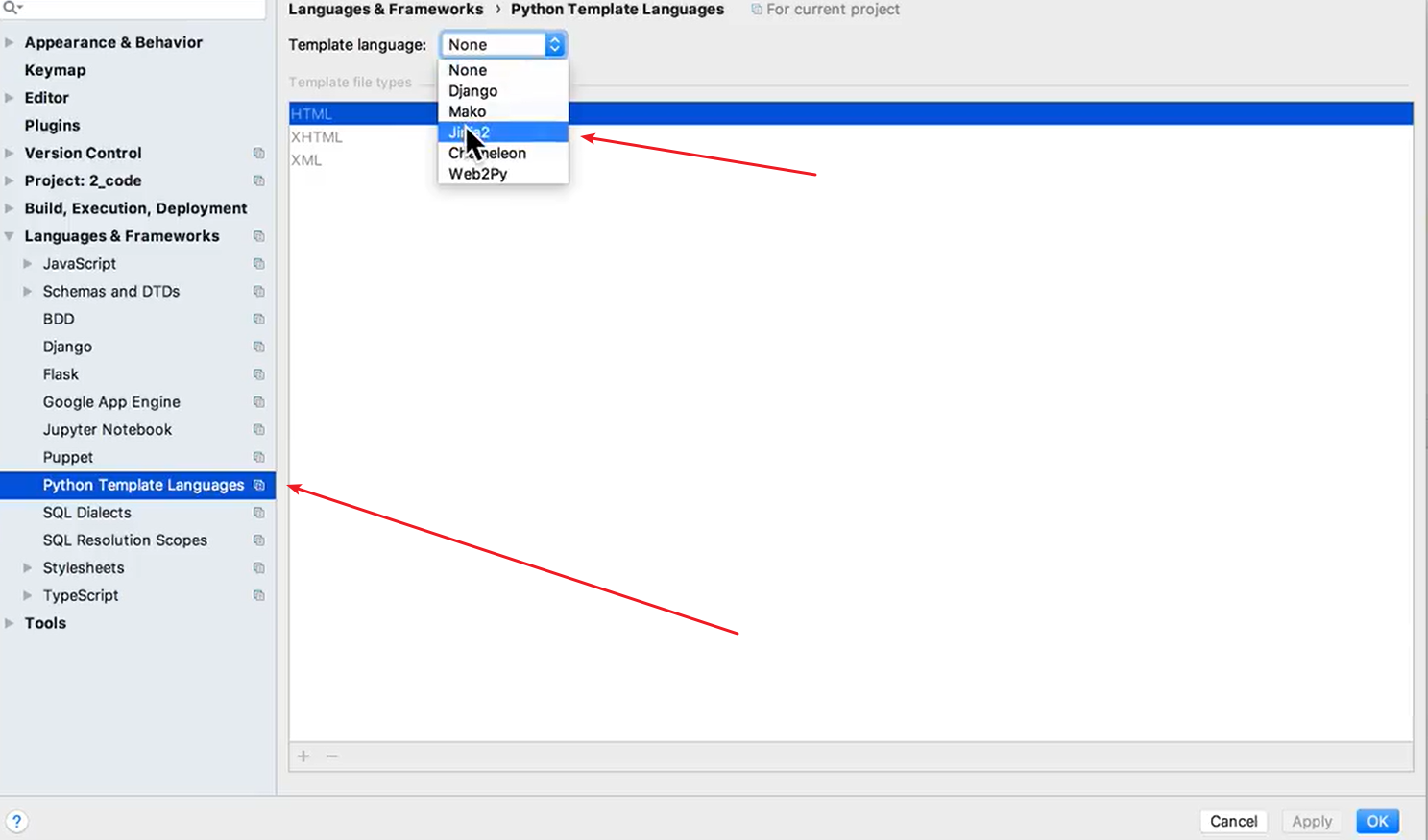
from flask import Flask,render_template
app = Flask(__name__)
@app.route('/')
def hello_world():
response = render_template('template.html')
return response
if __name__ == '__main__':
app.run(debug=True)
template.html文件
<!DOCTYPE html>
<html lang="en">
<head>
<meta charset="UTF-8">
<title>Title</title>
<style>
.box{
300px;
height: 300px;
background: red;
}
</style>
</head>
<body>
<div class="box">
</div>
</body>
</html>
六、模板语法,获取变量
- 解释: 在模板中获取视图函数的变量
- 格式:
- {{ 变量 }}
from flask import Flask,render_template
app = Flask(__name__)
@app.route('/')
def hello_world():
#1.定义各种类型的变量
number = 10
str = "老王"
tuple = (1,2,3,4,5)
list = [6,7,8,9,10]
dict = {
"name":"班长",
"age":29
}
#2.携带变量到模板中展示
return render_template("variable.html",number=number,str=str,tuple=tuple,list=list,dict=dict)
if __name__ == '__main__':
app.run(debug=True)
variable.html文件
<!DOCTYPE html>
<html lang="en">
<head>
<meta charset="UTF-8">
<title>Title</title>
</head>
<body>
<h1>1.获取各种变量的值</h1>
<h2>整数: {{number}}</h2>
<h2>字符串: {{str}}</h2>
<h2>元祖: {{tuple}},分开获取: {{tuple[0]}}, {{ tuple.1 }}</h2>
<h2>列表: {{list}},分开获取: {{ list.0 }}, {{ list.1 }}</h2>
{# 如果字典使用方括号,获取,需要写成字符串,如果不是字符串,那么则会被当成变量对待 #}
<h2>字典: {{dict}}, 分开获取: {{ dict.name }}, {{ dict["age"] }}</h2>
</body>
</html>
七、模板语法,分支循环判断
-
模板语法的种类
-
分支格式:
{% if 条件 %} 语句1 {% else%} 语句2 {% endif %} -
循环语句格式:
{% for 变量 in 容器 %} {% endfor %} -
注释:
{# 这里是注释的内容 #}
-
from flask import Flask,render_template
app = Flask(__name__)
@app.route('/')
def hello_world():
#1.定义各种类型的变量
number = 10
str = "老王"
tuple = (1,2,3,4,5)
list = [6,7,8,9,10]
dict = {
"name":"班长",
"age":29
}
#2.携带变量到模板中展示
return render_template("programer.html",number=number,str=str,tuple=tuple,list=list,dict=dict)
if __name__ == '__main__':
app.run(debug=True)
对应的html
<!DOCTYPE html>
<html lang="en">
<head>
<meta charset="UTF-8">
<title>Title</title>
<style>
h1{
color:red;
}
</style>
</head>
<body>
<h1>1.遍历元祖中的偶数</h1>
{% for item in tuple %}
{% if item %2 == 0 %}
<h3>{{ item }}</h3>
{% endif %}
{% endfor %}
<h1>2.遍历字典</h1>
{% for key in dict %}
{# dict.key那么这个key会当成字典中的一个键, dict[key],那么这个key当成一个变量 #}
<h3>{{ key }} = {{ dict[key] }}</h3>
{% endfor %}
</body>
</html>
八、系统字符串过滤器
- 解释: 过滤器,用来过滤想要的数据
- 格式: {{ 字符串 | 字符串过滤器 }}
- 常见的字符串过滤器有:
- title: 将每个单词的首字母都大写
- lower: 将每个单词都小写
- upper: 将每个单词都大写
- reverse: 反转
- ....
from flask import Flask,render_template
app = Flask(__name__)
@app.route('/')
def hello_world():
return render_template("stringfilter.html")
if __name__ == '__main__':
app.run(debug=True)
对应的html
<!DOCTYPE html>
<html lang="en">
<head>
<meta charset="UTF-8">
<title>Title</title>
</head>
<body>
{# 使用格式:{{ 字符串 | 字符串过滤器 }}#}
1.safe:禁用转义,让标签生效
<p>{{ '<em>hello</em>' | safe }}</p>
2.capitalize:把变量值的首字母转成大写,其余字母转小写
<p>{{ 'hello PYTHON' | capitalize }}</p>
3.lower:把值转成小写
<p>{{ 'HELLO PYthON' | lower }}</p>
4.upper:把值转成大写,中文没有大小写
<p>{{ 'hello python 你好' | upper }}</p>
5.title:把值中的每个单词的首字母都转成大写
<p>{{ 'hello world python java' | title }}</p>
6.reverse:字符串反转
<p>{{ 'olleh' | reverse }}</p>
<p>{{ '我爱你' | reverse }}</p>
7.format:格式化输出
<p>{{ '%s is %d' | format('age',17) }}</p>
8.striptags:渲染之前把值中所有的HTML标签都删掉
<p>{{ '<em>hello</em>' | striptags }}</p>
</body>
</html>
九、系统列表过滤器
- 解释: 过滤器,用来过滤想要的数据
- 格式: {{ 列表 | 列表过滤器 }}
- 常见的列表过滤器有:
- first: 获取列表第一个元素
- last: 最后一个元素
- sum: 列表和
- length: 列表长度
- ....
from flask import Flask,render_template
app = Flask(__name__)
@app.route('/')
def hello_world():
return render_template("list_fliter.html")
if __name__ == '__main__':
app.run(debug=True)
对应的html
<!DOCTYPE html>
<html lang="en">
<head>
<meta charset="UTF-8">
<title>Title</title>
</head>
<body>
{# * 使用格式:{{ 列表 | 列表过滤器 }}#}
1.first:取第一个元素
<p>{{ [1,2,3,4,5,6] | first }}</p>
2. last:取最后一个元素
<p>{{ [1,2,3,4,5,6] | last }}</p>
3. length:获取列表长度
<p>{{ [1,2,3,4,5,6] | length }}</p>
4.sum:列表求和
<p>{{ [1,2,3] | sum }}</p>
5.sort:列表排序,默认升序
<p>{{ [6,2,3,1,5,4] | sort }}</p>
6.过滤器的链式调用
{# 过滤器的链式调用 #}
{{ "hello" | upper | reverse }}
</body>
</html>
十、自定义过滤器
-
解释: 当系统提供的过滤器满足不了需求的时候,需要自定义
-
自定义过滤器有两种格式:
-
1.先定义好函数,再将函数添加到系统默认的过滤器列表中
- def 函数名: pass
- app.add_template_filter(函数名,'过滤器名字')
-
2.定义函数的时候,直接使用系统过滤器进行装饰
@app.template_filter('过滤器名字') def 函数名(): pass -
案例:
-
1.获取列表偶数和
-
2.反转列表
-
from flask import Flask,render_template
app = Flask(__name__)
# 1.先定义好函数,再将函数添加到系统默认的过滤器列表中
def get_oushu(list):
print(list)
sum = 0
for i in list:
if i %2 == 0:
sum += i
return sum
#参数1: 关联的函数名称, 参数2: 在模板中使用的过滤器名字
app.add_template_filter(get_oushu,"oushu")
# 2.定义函数的时候,直接使用系统过滤器进行装饰
@app.template_filter("reverse")
def listreverse(list):
list.reverse()
return list
@app.route('/')
def hello_world():
return render_template("custom_filter.html")
if __name__ == '__main__':
app.run(debug=True)
html
<!DOCTYPE html>
<html lang="en">
<head>
<meta charset="UTF-8">
<title>Title</title>
</head>
<body>
<h2>原列表: {{ [1,2,3,4,5,6] }}</h2>
<h2>偶数列表: {{ [1,2,3,4,5,6] | oushu }}</h2>
<h2>反转列表: {{ [1,2,3,4,5,6] | reverse }}</h2>
<h2>降序列表: {{ [1,2,3,4,5,6,10,9,7] | sort | reverse }}</h2>
</body>
</html>
十一、代码复用之宏
-
解释: 相当于python中的函数,定义好一段功能,在需要的时候进行调用即可
-
定义格式:
{% macro 宏名(参数) %} {% endmacro %} -
使用格式:
// 使用当前文件定义好的宏 {{ 宏名(参数) }} //使用其他文件定义好的宏 {% import '文件' as 别名%} {{ 别名.宏名(参数) }}
from flask import Flask,render_template
app = Flask(__name__)
@app.route('/')
def hello_world():
return render_template("file07macro.html")
if __name__ == '__main__':
app.run(debug=True)
使用
<!DOCTYPE html>
<html lang="en">
<head>
<meta charset="UTF-8">
<title>Title</title>
</head>
<body>
{# 定义宏 #}
{% macro my_macro(name,password) %}
用户名: <input type="text" value="{{ name }}"><br>
密码: <input type="password" value="{{ password }}"><br>
{% endmacro %}
{# 调用当前文件宏 #}
{{ my_macro("zhangsan","111111") }}
{# 使用其他文件的宏 #}
{% import 'othermacro.html' as other %}
{{ other.my_input() }}
{{ other.my_div() }}
</body>
</html>
othermacro.html
{% macro my_macro(name,password) %}
用户名: <input type="text" value="{{ name }}"><br>
密码: <input type="password" value="{{ password }}"><br>
{% endmacro %}
{% macro my_input() %}
<h1>这是一个其他文件的宏</h1>
{% endmacro %}
{% macro my_div() %}
<div style="color: red;">我是一个孤独的div</div>
{% endmacro %}
十二、代码复用之继承
-
解释: 一个子模板继承自父模板
-
作用: 共性抽取,代码复用
-
父模板
- 1.所有子类都具有的相同的内容的, 在父模板中直接写死
- 2.每个子类的模板中不一样的内容,使用block模板定义好
-
子模板
- 1.根据子类自己的需求,去重写父类中的block对应的内容
- 2.如果重写之后,还想保留父类的内容,那么使用{{super()}}
- 3.继承格式: {% extends '父文件名'%}, 写在页面的顶部
-
注意点:
-
定义block的格式
{% block 名称 %} {% endblock %}
-
from flask import Flask,render_template
app = Flask(__name__)
@app.route('/')
def hello_world():
# return render_template("file09zi.html")
return render_template("file10zi.html")
if __name__ == '__main__':
app.run(debug=True)
file11fu.html
<!DOCTYPE html>
<html lang="en">
<head>
<meta charset="UTF-8">
<title>Title</title>
</head>
<body>
{# 头部部分 #}
{% block titleBlock %}
<h1>静夜思</h1>
{% endblock %}
{# 正文部分 #}
{% block contentBlock %}
{% endblock %}
{# 底部部分 #}
<div>
<a href="#">点我有惊喜</a>
</div>
</body>
</html>
file09zi.html
{% extends 'file11fu.html' %}
{# 重写正文部分 #}
{% block contentBlock %}
<p>
床前一锅汤,<br>
撒了一裤裆, <br>
抬头拿抹布, <br>
低头擦裤裆 <br>
</p>
{% endblock %}
{#<!DOCTYPE html>#}
{#<html lang="en">#}
{#<head>#}
{# <meta charset="UTF-8">#}
{# <title>Title</title>#}
{#</head>#}
{#<body>#}
{##}
{# <h1>静夜思</h1>#}
{##}
{# <p>#}
{# 床前一锅汤,<br>#}
{# 撒了一裤裆, <br>#}
{# 抬头拿抹布, <br>#}
{# 低头擦裤裆 <br>#}
{# </p>#}
{##}
{# <div>#}
{# <a href="#">点我有惊喜</a>#}
{# </div>#}
{##}
{##}
{#</body>#}
{#</html>#}
file10zi.html
{% extends 'file11fu.html' %}
{# 重写父类titleBlock内容 #}
{% block titleBlock %}
{{ super() }}
<h1>新静夜思</h1>
{% endblock %}
{# 重写父类中的contentBlock内容 #}
{% block contentBlock %}
<p>
床前明月光,<br>
疑似地上霜, <br>
举头望明月, <br>
低头思故乡 <br>
</p>
{% endblock %}
{#<!DOCTYPE html>#}
{#<html lang="en">#}
{#<head>#}
{# <meta charset="UTF-8">#}
{# <title>Title</title>#}
{#</head>#}
{#<body>#}
{##}
{# <h1>静夜思</h1>#}
{##}
{# <p>#}
{# 床前明月光,<br>#}
{# 疑似地上霜, <br>#}
{# 举头望明月, <br>#}
{# 低头思故乡 <br>#}
{# </p>#}
{##}
{# <div>#}
{# <a href="#">点我有惊喜</a>#}
{# </div>#}
{##}
{##}
{#</body>#}
{#</html>#}
十三、代码复用之包含
-
解释: 在一个文件中完全拥有另外一个文件,不够灵活,没法扩展
-
格式:
方式一: {% include '文件' %} 方式二: {% include '文件' ignore missing %} -
注意点: ignore missing 如果包含的文件不存在,也不会报错
十四、模板使用练习
- 题目: 给出5条数据,显示前四条
"""
给定如下5条数据,只显示4行数据,背景颜色依次为:黄,绿,红,紫
my_list = [
{
"id": 1,
"value": "我爱工作"
},
{
"id": 2,
"value": "工作使人快乐"
},
{
"id": 3,
"value": "沉迷于工作无法自拔"
},
{
"id": 4,
"value": "日渐消瘦"
},
{
"id": 5,
"value": "以梦为马,越骑越傻"
}
]
"""
from flask import Flask, render_template
app = Flask(__name__)
@app.route('/')
def hello_world():
#1.定义5条数据
my_list = [
{
"id": 1,
"value": "我爱工作"
},
{
"id": 2,
"value": "工作使人快乐"
},
{
"id": 3,
"value": "沉迷于工作无法自拔"
},
{
"id": 4,
"value": "日渐消瘦"
},
{
"id": 5,
"value": "以梦为马,越骑越傻"
}
]
#2.在模板中显示4条
return render_template("practice.html",list=my_list)
if __name__ == '__main__':
app.run(debug=True)
practice.html
<!DOCTYPE html>
<html lang="en">
<head>
<meta charset="UTF-8">
<title>Title</title>
</head>
<body>
<ul>
{# 如果dict.id 不等于5才遍历 #}
{% for dict in list if dict.id !=5 %}
{# 方式一 #}
{# {% if dict.id == 1 %}#}
{# <li style="background: yellow;"> {{ dict.value }} </li>#}
{# {% elif dict.id == 2 %}#}
{# <li style="background: green;"> {{ dict.value }} </li>#}
{# {% elif dict.id == 3 %}#}
{# <li style="background: red;"> {{ dict.value }} </li>#}
{# {% else %}#}
{# <li style="background: purple;"> {{ dict.value }} </li>#}
{# {% endif %}#}
{# 遍历的时候可以获取到从0开始的索引 #}
{# <h3>{{ loop.index0 }}</h3>#}
{# 遍历的时候可以获取到从1开始的索引 #}
{# <h3>{{ loop.index }}</h3>#}
{# 方式二 #}
{% if loop.index == 1 %}
<li style="background: yellow;"> {{ dict.value }} </li>
{% elif loop.index == 2 %}
<li style="background: green;"> {{ dict.value }} </li>
{% elif loop.index == 3 %}
<li style="background: red;"> {{ dict.value }} </li>
{% else %}
<li style="background: purple;"> {{ dict.value }} </li>
{% endif %}
{% endfor %}
</ul>
</body>
</html>
十五、模板特有变量
- 解释: 不需要通过python程序传递就可以直接使用的变量
- 常见的特有变量如下:
- config: 就是flask中的app.config, 表示应用程序中的所有配置信息
- request: 表示请求上下文对象,封装的是请求相关的数据
- g: 局部的全局变量(了解)
- url_for(): 反解析,通过函数的名字,解析到视图函数的路径
- get_flashed_messsages(): 用来消耗flash方法中存储的消息.
- 场景: 登陆出错,可以显示
- 注意点:
- 1.使用flash存储消息的时候需要设置SECRET_KEY
- 2.因为flash内部的消息存储,依赖于了session
from flask import Flask,render_template
app = Flask(__name__)
app.config["SECRET_KEY"] ="hahaha"
@app.route('/')
def hello_world():
return render_template("special_variable.html")
@app.route('/test/<int:age>')
def test(age):
return "test..."
if __name__ == '__main__':
app.run(debug=True)
special_variable.html
<!DOCTYPE html>
<html lang="en">
<head>
<meta charset="UTF-8">
<title>Title</title>
</head>
<body>
<h2>config变量: {{ config }}</h2>
<h2>request: {{ request.method }}</h2>
<h2>request: {{ request.url }}</h2>
<h2>url_for(): {{ url_for("hello_world") }}</h2>
<h2>url_for(): {{ url_for("test",age=100) }}</h2>
</body>
</html>
get_flashed_messsages()的使用
from flask import Flask,render_template,flash
app = Flask(__name__)
app.config["SECRET_KEY"] = "onjgtex"
@app.route('/')
def hello_world():
return render_template("flash.html")
@app.route('/test')
def test():
#存储消息
flash("登陆成功")
return "test"
if __name__ == '__main__':
app.run(debug=True)
flash.html
用来消耗flash方法中存储的消息
<!DOCTYPE html>
<html lang="en">
<head>
<meta charset="UTF-8">
<title>Title</title>
</head>
<body>
{{ get_flashed_messages() }}
</body>
</html>
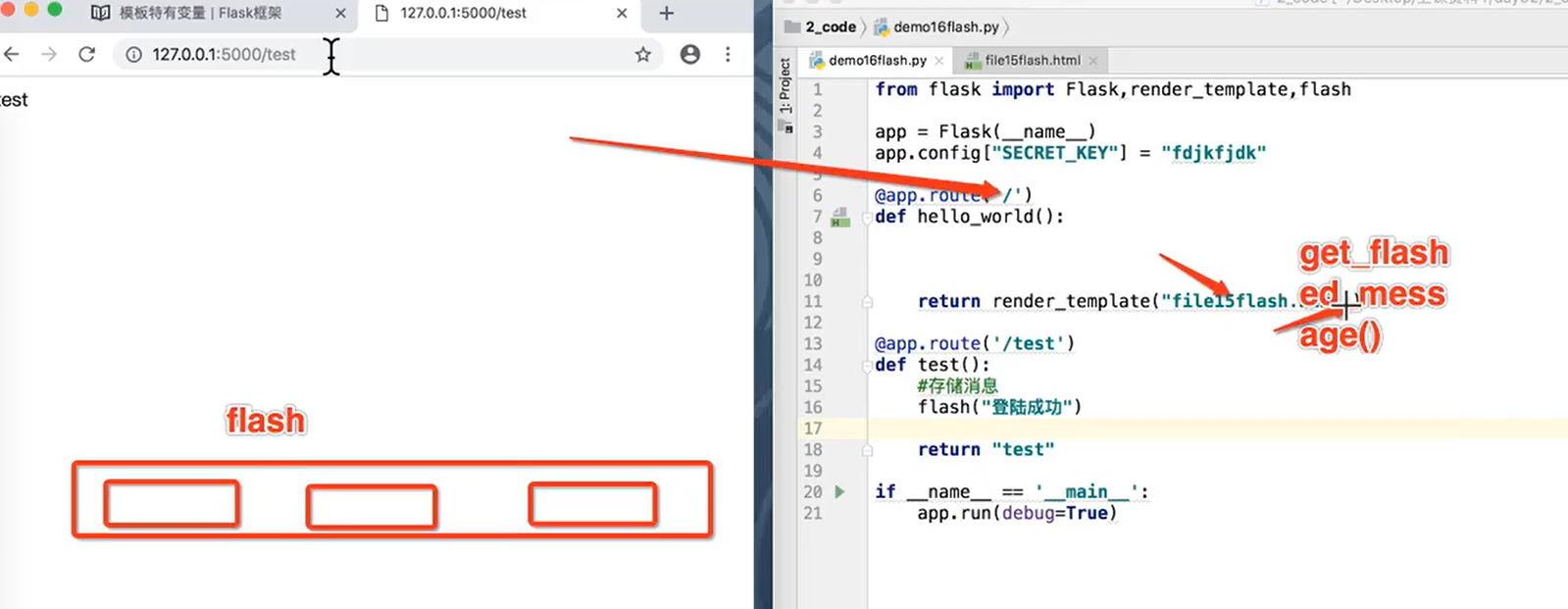
十六、csrf攻击流程
- 解释: 跨站点请求伪造
- 掌握: 需要理解讲义中的攻击流程图
- 代码演示: webA, webB
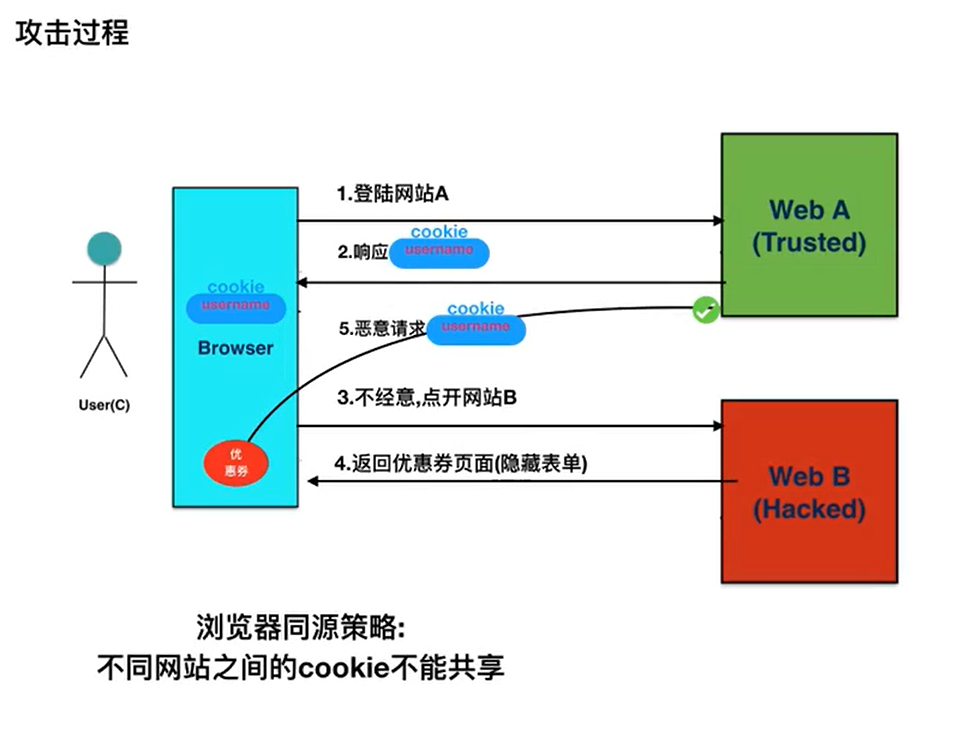
十七、csrf攻击手动解决
- 在cookie增加一个csrf_token
- 在表单中增加一个csrf_token
- 校验: 取出cookie和表单中的csrf_token比较如果二者一致那么是正常请求
- 具体过程,看keynote图解
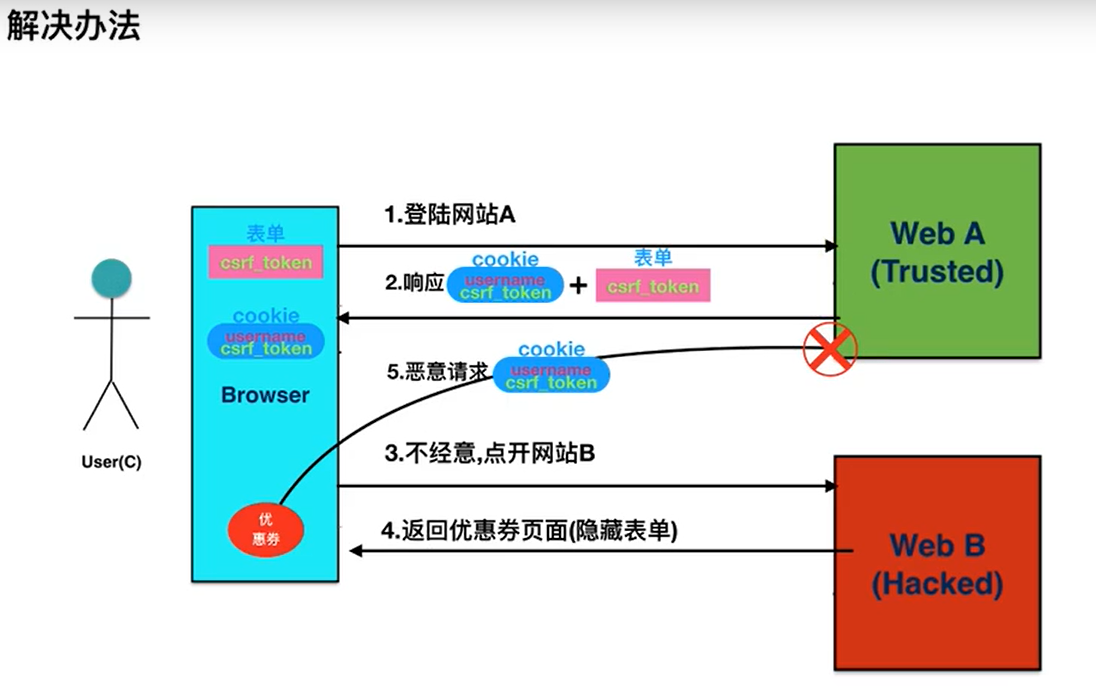
十八、CSRFProtect解决csrf
- 使用流程:
- 1.安装扩展包
- pip install flask-wtf
- 2.导入包
- from flask_wtf.csrf import CSRFProtect
- 3.设置SECRET_KEY,便于csrf_token加密
- 4.创建CSRFProtect对象,保护app对象
- 5.需要在表单中设置csrf_token隐藏字段即可
- 例子: 注册案例
- 注意点: CSRFProtect一旦保护了app之后, 会对'POST', 'PUT', 'PATCH', 'DELETE'做校验.
- 1.安装扩展包
from flask import Flask, render_template, request
from flask_wtf.csrf import CSRFProtect
app = Flask(__name__)
# 1. 先设置密钥
app.config["SECRET_KEY"] = "weorinsaiudfhnb"
# 2. 保护app
CSRFProtect(app)
@app.route('/', methods=["GET", "POST"])
def index():
if request.method == "POST":
# 获取到参数
username = request.form.get("username")
password = request.form.get("password")
repassword = request.form.get("repassword")
# 校验参数
if not all([username, password, repassword]):
return "参数填写不全"
# 判断两次的密码是否一致
if password != repassword:
return "两次密码输入不一致,请重新输入"
return "注册成功"
else:
return render_template("register.html")
if __name__ == '__main__':
app.run()
对应的register.html
<!DOCTYPE html>
<html lang="en">
<head>
<meta charset="UTF-8">
<title>Title</title>
</head>
<body>
<form action="/" method="post">
{# 3. 只要使用了CSRFProtect保护app,就可以直接使用csrf_token()作为value值 #}
<input type="hidden" name="csrf_token" value="{{ csrf_token() }}">
用户名:<input type="text" name="username"><br>
密码:<input type="password" name="password"><br>
确认密码:<input type="password" name="repassword"><br>
<input type="submit" value="注册">
</form>
</body>
</html>